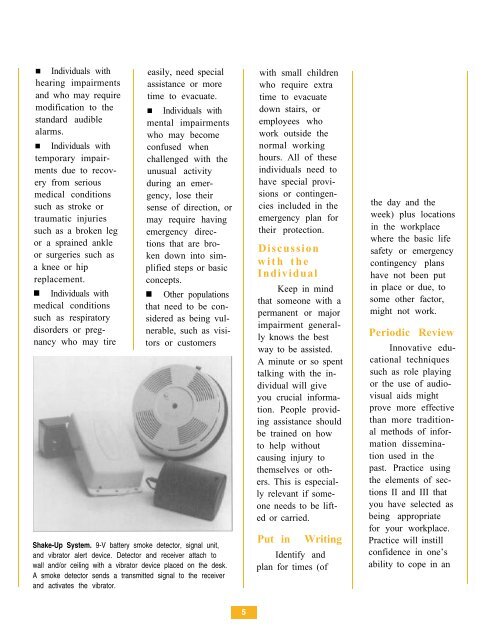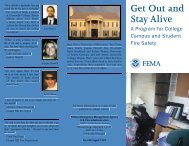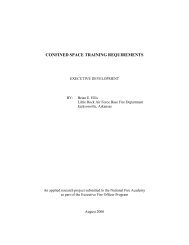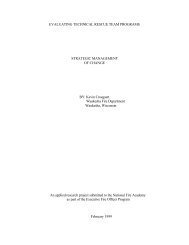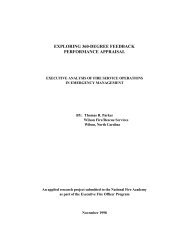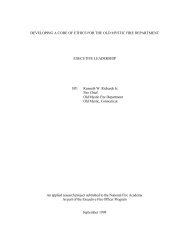Emergency Procedures for Employees with Disabilities - US Fire ...
Emergency Procedures for Employees with Disabilities - US Fire ...
Emergency Procedures for Employees with Disabilities - US Fire ...
Create successful ePaper yourself
Turn your PDF publications into a flip-book with our unique Google optimized e-Paper software.
Individuals <strong>with</strong><br />
hearing impairments<br />
and who may require<br />
modification to the<br />
standard audible<br />
alarms.<br />
Individuals <strong>with</strong><br />
temporary impairments<br />
due to recovery<br />
from serious<br />
medical conditions<br />
such as stroke or<br />
traumatic injuries<br />
such as a broken leg<br />
or a sprained ankle<br />
or surgeries such as<br />
a knee or hip<br />
replacement.<br />
Individuals <strong>with</strong><br />
medical conditions<br />
such as respiratory<br />
disorders or pregnancy<br />
who may tire<br />
easily, need special<br />
assistance or more<br />
time to evacuate.<br />
Individuals <strong>with</strong><br />
mental impairments<br />
who may become<br />
confused when<br />
challenged <strong>with</strong> the<br />
unusual activity<br />
during an emergency,<br />
lose their<br />
sense of direction, or<br />
may require having<br />
emergency directions<br />
that are broken<br />
down into simplified<br />
steps or basic<br />
concepts.<br />
Other populations<br />
that need to be considered<br />
as being vulnerable,<br />
such as visitors<br />
or customers<br />
Shake-Up System. 9-V battery smoke detector, signal unit,<br />
and vibrator alert device. Detector and receiver attach to<br />
wall and/or ceiling <strong>with</strong> a vibrator device placed on the desk.<br />
A smoke detector sends a transmitted signal to the receiver<br />
and activates the vibrator.<br />
5<br />
<strong>with</strong> small children<br />
who require extra<br />
time to evacuate<br />
down stairs, or<br />
employees who<br />
work outside the<br />
normal working<br />
hours. All of these<br />
individuals need to<br />
have special provisions<br />
or contingencies<br />
included in the<br />
emergency plan <strong>for</strong><br />
their protection.<br />
Discussion<br />
<strong>with</strong> the<br />
Individual<br />
Keep in mind<br />
that someone <strong>with</strong> a<br />
permanent or major<br />
impairment generally<br />
knows the best<br />
way to be assisted.<br />
A minute or so spent<br />
talking <strong>with</strong> the individual<br />
will give<br />
you crucial in<strong>for</strong>mation.<br />
People providing<br />
assistance should<br />
be trained on how<br />
to help <strong>with</strong>out<br />
causing injury to<br />
themselves or others.<br />
This is especially<br />
relevant if someone<br />
needs to be lifted<br />
or carried.<br />
Put in Writing<br />
Identify and<br />
plan <strong>for</strong> times (of<br />
the day and the<br />
week) plus locations<br />
in the workplace<br />
where the basic life<br />
safety or emergency<br />
contingency plans<br />
have not been put<br />
in place or due, to<br />
some other factor,<br />
might not work.<br />
Periodic Review<br />
Innovative educational<br />
techniques<br />
such as role playing<br />
or the use of audiovisual<br />
aids might<br />
prove more effective<br />
than more traditional<br />
methods of in<strong>for</strong>mationdissemination<br />
used in the<br />
past. Practice using<br />
the elements of sections<br />
II and III that<br />
you have selected as<br />
being appropriate<br />
<strong>for</strong> your workplace.<br />
Practice will instill<br />
confidence in one’s<br />
ability to cope in an


